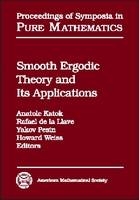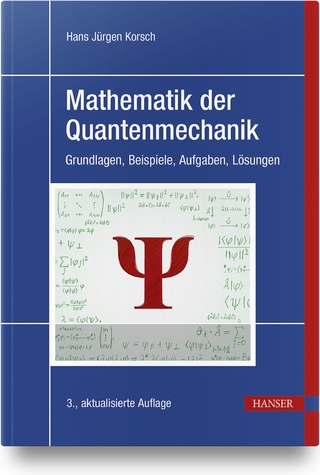
Smooth Ergodic Theory and Its Applications
American Mathematical Society (Verlag)
978-0-8218-2682-9 (ISBN)
During the past decade, there have been several major new developments in smooth ergodic theory, which have attracted substantial interest to the field from mathematicians as well as scientists using dynamics in their work. In spite of the impressive literature, it has been extremely difficult for a student - or even an established mathematician who is not an expert in the area - to acquire a working knowledge of smooth ergodic theory and to learn how to use its tools.Accordingly, the AMS Summer Research Institute on Smooth Ergodic Theory and Its Applications (Seattle, WA) had a strong educational component, including ten mini-courses on various aspects of the topic that were presented by leading experts in the field. This volume presents the proceedings of that conference. Smooth ergodic theory studies the statistical properties of differentiable dynamical systems, whose origin traces back to the seminal works of Poincare and later, many great mathematicians who made contributions to the development of the theory.The main topic of this volume, smooth ergodic theory, especially the theory of nonuniformly hyperbolic systems, provides the principle paradigm for the rigorous study of complicated or chaotic behavior in deterministic systems. This paradigm asserts that if a non-linear dynamical system exhibits sufficiently pronounced exponential behavior, then global properties of the system can be deduced from studying the linearized system. One can then obtain detailed information on topological properties (such as the growth of periodic orbits, topological entropy, and dimension of invariant sets including attractors), as well as statistical properties (such as the existence of invariant measures, asymptotic behavior of typical orbits, ergodicity, mixing, decay of correlations, and measure-theoretic entropy).Smooth ergodic theory also provides a foundation for numerous applications throughout mathematics (e.g., Riemannian geometry, number theory, Lie groups, and partial differential equations), as well as other sciences. This volume serves a two-fold purpose: first, it gives a useful gateway to smooth ergodic theory for students and nonspecialists, and second, it provides a state-of-the-art report on important current aspects of the subject. The book is divided into three parts: lecture notes consisting of three long expositions with proofs aimed to serve as a comprehensive and self-contained introduction to a particular area of smooth ergodic theory; thematic sections based on mini-courses or surveys held at the conference; and original contributions presented at the meeting or closely related to the topics that were discussed there.
Lecture notes: Lectures on Lyapunov exponents and smooth ergodic theory by L. Barreira and Ya. Pesin Cocycles, cohomology and combinatorial constructions in ergodic theory by A. Katok and E. A. Robinson, Jr. A tutorial on KAM theory by R. de la Llave Survey-expository articles: Systems with hyperbolic behavior by A. Katok Decay of correlations by V. Baladi Recent results about stable ergodicity by K. Burns, C. Pugh, M. Shub, and A. Wilkinson Statistical properties of some almost hyperbolic systems by H. Hu Random $f$-expansions by Y. Kifer Dynamical zeta functions by M. Pollicott An overview of the dimension theory of dynamical systems by J. Schmeling and H. Weiss Collet-Eckmann condition in one-dimensional dynamics by G. Swiatek Monotonicity, $/mathcal J$-algebra of Potapov and Lyapunov exponents by M. P. Wojtkowski Geodesic flows: Geodesic flows in manifolds of nonpositive curvature by P. Eberlein Closed geodesics and the uniqueness of the maximal measure for rank 1 geodesic flows by G. Knieper Algebraic systems and rigidity: Invariant measures for actions of higher rank abelian groups by B. Kalinin and A. Katok Some applications of homogeneous dynamics to number theory by D. Kleinbock Measurable rigidity of algebraic $/mathbb {Z}^d$-actions by K. Schmidt KAM-theory: Almost reducibility of linear quasi-periodic systems by L. H. Eliasson A lecture on the classical KAM theorem by J. Poschel A Lagrangian proof of the invariant curve theorem for twist mappings by M. Levi and J. Moser Research articles: Thermodynamical formalism for piecewise invertible maps: Absolutely continuous invariant measures as equilibrium states by J. Buzzi Smoothness of holonomy maps derived from unstable foliation by M. Guysinsky Schrodinger operators and topological pressure on manifolds of negative curvature by V. Nitica and F. Xavier Isoperimetric and ergodic properties of horospheres in symmetric spaces by N. Peyerimhoff Minimal but not uniquely ergodic diffeomorphisms by A. Windsor Piecewise smooth maps with absolutely continuous invariant measures and uniformly scaled Markov partitions by M. Jakobson.
| Erscheint lt. Verlag | 1.1.2002 |
|---|---|
| Reihe/Serie | Proceedings of Symposia in Pure Mathematics |
| Zusatzinfo | Illustrations |
| Verlagsort | Providence |
| Sprache | englisch |
| Gewicht | 1729 g |
| Themenwelt | Mathematik / Informatik ► Mathematik ► Analysis |
| Mathematik / Informatik ► Mathematik ► Geometrie / Topologie | |
| ISBN-10 | 0-8218-2682-4 / 0821826824 |
| ISBN-13 | 978-0-8218-2682-9 / 9780821826829 |
| Zustand | Neuware |
| Haben Sie eine Frage zum Produkt? |
aus dem Bereich


